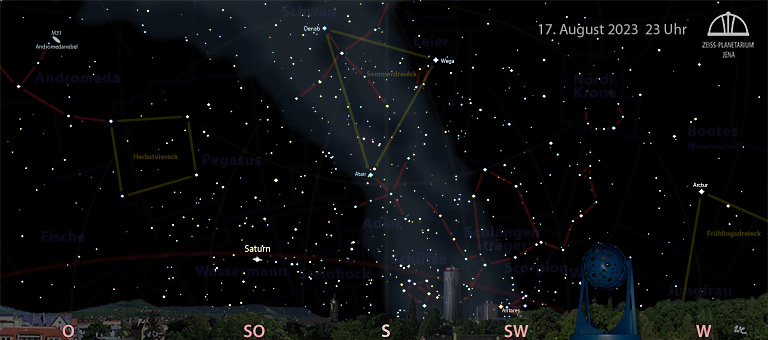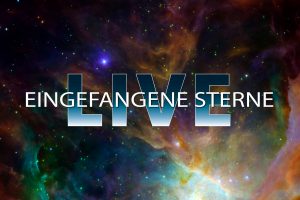3 Planeten und Sternschnuppen
In diesem Monat nimmt die Länge des hellen Tages bereits wieder um eine Stunde ab. Die Sonne verlässt am 11. das Tierkreissternbild Krebs und zieht vor den Löwen.
Vollmond ist am 1. und 31. August, Neumond am 16.
Die Hochsommernächte werden vom Sommerdreieck beherrscht. Hoch im Süden funkeln mit Deneb im Schwan und Wega in der Leier zwei der hellsten Sterne am irdischen Himmel. Unter ihnen vollendet der Atair im Adler das prachtvolle Dreieck. Das Sternbild Schwan ist auch als Kreuz des Nordens gut zu finden. In einer ganz klaren Nacht kann man sich gut vorstellen, wie beide Vögel mit ausgebreiteten Schwingen über das matt schimmernde Band der Milchstraße zu gleiten scheinen. Aber dafür sind schon sehr gute Sichtbedingungen erforderlich. Vier nicht sehr lichtstarke Sternchen, die ein kleines Parallelogramm bilden, formen zusammen mit der Wega das Sternbild Leier. Flach über dem Südhorizont sind die sommerlichen Tierkreissternbilder Waage, Skorpion, Schlangenträger, Schütze und Steinbock zu finden. Der rötlich funkelnde Stern Antares des Skorpions ist recht gut auszumachen.
Jupiter wird allmählich zum Planeten der ganzen Nacht. Er steht vor dem Tierkreissternbild Widder. Der Ringplanet Saturn steht vor dem Tierkreissternbild Wassermann am 27. in Opposition zur Sonne und ist in diesem Monat Planet der ganzen Nacht. Mars ist in diesem Monat nicht sichtbar. Venus hat sich vom Abendhimmel verabschiedet und erscheint gegen Ende des Monats am Morgenhimmel.
Am östlichen Himmel strahlen die Sterne des Herbstvierecks aus Pegasus und Andromeda.
Scheinbar aus dem Sternbild Perseus im Osten kommend, kann man die Sternschnuppen des Perseiden-Stroms erwarten, deren Maximum am Morgen des 13. August liegt.
W. Don Eck
Zeiss-Planetarium Jena
3 Planets and shooting stars
This month the length of the bright day decreases by another hour. The Sun leaves the zodiac constellation Cancer on the 11th and moves in front of Leo.
Full moon is on 1 and 31 August, new moon on 16 August.
The midsummer nights are dominated by the summer triangle. High in the south, Deneb in the Swan and Vega in the Lyre are two of the brightest stars in the earthly sky. Below them, Atair in the Eagle completes the magnificent triangle. The constellation of the Swan is also easy to find as the Northern Cross. On a very clear night, you can easily imagine how both birds seem to glide with outstretched wings over the dull shimmering band of the Milky Way. But this requires very good viewing conditions. Four not very bright stars, forming a small parallelogram, together with Vega form the constellation Lyra. Flat above the southern horizon are the summer zodiacal constellations of Libra, Scorpio, Serpent Bear, Sagittarius and Capricorn. The reddish twinkling star Antares of Scorpio is quite easy to spot.
Jupiter gradually becomes the planet of the whole night. It is in front of the zodiac constellation Aries. The ring planet Saturn is in opposition to the Sun in front of the zodiacal constellation Aquarius on the 27th and is planet of the whole night this month. Mars is not visible this month. Venus has departed from the evening sky and appears in the morning sky towards the end of the month.
The stars of the autumn quadrilateral of Pegasus and Andromeda shine in the eastern sky.
Apparently coming from the constellation Perseus in the east, you can expect the shooting stars of the Perseids stream, whose maximum is on the morning of 13 August.
W. Don Eck
Zeiss-Planetarium Jena
Eingefangene Sterne – Live
Der Sternhimmel über Jena und monatlich wechselnde Themen
Wir berichten live über den aktuellen Sternhimmel und helfen Ihnen dabei Sterne und Sternbilder zu entdecken. Weiterhin informieren wir Sie über die neuesten Entdeckungen und Entwicklungen in Astronomie sowie bahnbrechende Erkenntnisse über unser Universum und aktuelle Unternehmungen in der Raumfahrt. Monatlich vertiefen wir ein spezielles Thema. Ausdrücklich erwünscht sind Ihre Fragen, Anregungen oder Themenwünsche, die Sie an sternelivefragen@planetarium-jena.de richten oder live in der Veranstaltung äußern können.
Mittwoch • 02.08. • 19:00 Uhr
Woher kommen die Tiere?
Prof. Dr. Andreas Hejnol & Team (Phyletischen Museums)
Neue Methoden in der Forschung haben unsere Vorstellungen von der Evolution der Tiere verändert. Begegnen Sie hier unseren am weitest verwandten Cousinen, den Rippenquallen.
Samstag • 19.08. • 16:00 Uhr
Biologische Vielfalt zwischen Anden und Amazonas
Dr. Gunnar Brehm (Phyletisches Museum Jena)
Die meisten Insekten der Regenwälder Südamerikas sind noch unbekannt. Wir erforschen ihre Vielfalt zwischen dem Tiefland des Amazonas und Anden-Elfenwäldern.
Captured Stars – Live
The starry sky over Jena and monthly changing topics
We report live about the current starry sky and help you to discover stars and constellations. Furthermore, we inform you about the latest discoveries and developments in astronomy as well as groundbreaking findings about our universe and current ventures in space travel. Every month, we delve into a special topic. We expressly welcome your questions, suggestions or topic requests, which you can send to sternelivefragen@planetarium-jena.de or express live at the event.
Wednesday – 02.08. – 7:00 pm
Where do animals come from?
Prof. Dr. Andreas Hejnol & Team (Phyletic Museum)
New methods in research have changed our ideas about the evolution of animals. Meet our most distantly related cousins, the ribbed jellyfish.
Saturday – 19.08. – 4:00 pm
Biodiversity between the Andes and the Amazon
Dr. Gunnar Brehm (Phyletic Museum Jena)
Most insects of the rainforests of South America are still unknown. We explore their diversity between the lowlands of the Amazon and Andean elfin forests.



